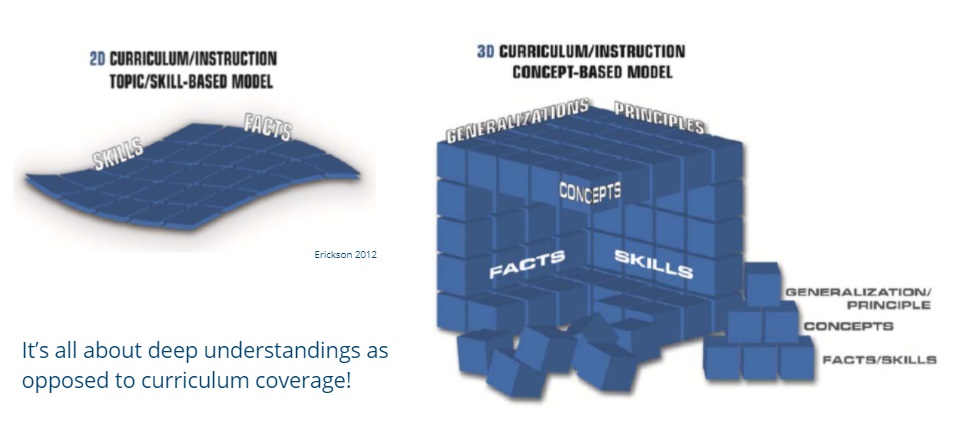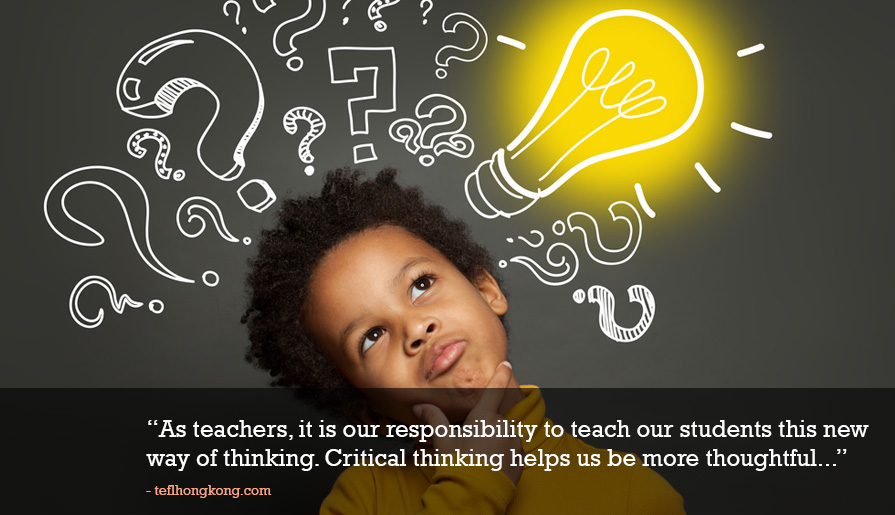Many of us grew up with the education practices of direct instruction with independent practice. We were taught to “sit and get” and regurgitate the information back on weekly assessments.
Concept-based curriculum and instruction(CBCI) has transformed learning to provide more quality and lifelong learning by emphasizing the need for deep understanding of concepts versus simply memorization. Concept-based curriculum and instruction is a three-dimensional approach that focuses on what the students know, understand, and can do after a lesson while traditional instruction focuses more on what students know and can do. Developing a deep understanding, the missing key in traditional curriculum, is essential in developing critically thinking adults and lifelong learners.

Want to know more? Check out video below on teaching conceptual understanding.
Why CBCI and How It Has Benefited My Classroom
As an educator, CBCI has influenced my thinking and evolved my style of teaching to best benefit my students’ needs. “Concept-Based Curriculum and Instruction for the Thinking Classroom” highlights some of the reasons why CBCI is so beneficial for this generation of learners.
With CBCI, less is more.
Often, as educators, we find ourselves in the struggle of trying to cover all of the standards with limited time to do so. CBCI encourages focusing on fewer items allowing time for students to focus on the information in detail so they are likely to remember it. (Sousa, 2011a, as cited in Erickson et. al, 2017, p.10) Curriculum should be organized in “important, transferable understandings” (Erickson et. al, 2017, p.10).
As a classroom teacher of 14 years, I have seen the importance of focusing on critical concepts and using them to dig deep and ensure my students not only know that information but understand it well enough to teach others and apply it to other disciplines.
CBCI empowers student ownership by promoting creativity and critical thinking.
When students take an active role in their learning, they learn and retain more because they are being personally invested and their motivation increases. (Erickson et. al, 2017). CBCI design focuses on merging lower and higher levels of thinking, also known as synergistic thinking. “Understanding requires knowledge, but goes beyond it.” (Ritchhart, 2015, as cited in Erickson et. al, 2017, p.10). Developing creative thinking skills in the classroom is essential.
Creative thinking is the starting point of the inventions and advancements around us. Erickson, Lanning, and French sums it up best by saying “The future of our world depends on the marriage of creative, critical, conceptual and reflective thinking” (Erickson et. al, 2017, p.10)

Challenging my students to be able to explain their thinking to others, write explanations, model their thinking, and teach others math concepts instead of just providing “the right answer” has been a powerful transition in the classroom from me being the keeper of knowledge to becoming a facilitator. This experience has not only transformed my students but also allowed me to see concepts in different ways and gain another perspective. I find my students pushing themselves further to discover multiple ways to approach a problem rather than settling for one way which sparks the curiosity of others and total engagement of the class.
CBCI develops transferable skills promoting retention of knowledge.
CBCI aids the development of skills that transfer to other contexts. Through CBCI design, students learn critical thinking, problem solving, and inquiry skills that they can apply to future situations. (Erickson et. al, 2017)
As I incorporate CBCI into the classroom more, I have noticed my students acquiring more advanced skills and communicating their learning at a higher level. My students are able to make connections between subjects and recall information longer.
My Unit Plan
Unit Title: Ecosytems: We are all in this together
Concepts: Interactions, Relationships, Interdependence
Topic: Food chains, Food webs, Invasive species
Unit Overview: My CBCI unit will be on ecosystems. My students will explore how organisms depend on each other for energy and how invasive species can affect ecosystems and the flow of energy. My students will make personal connections by finding examples of these situations in Ohio. My students will explore ecosystems through dissecting pellets, creating terrariums, and other hand-on activities that will give them an authentic representation of ecosystems.
Challenges that I anticipate
The challenges that I anticipate are language barriers that are present with my current group. My population of students includes ELL students, 3 of which are emergent English speakers. Despite this challenge, deep understanding is still the goal. I will anticipate this challenge by being prepared with a visuals and translations that may be helpful. I will also provide several opportunites to engage in the content in an interactive and hands-on purposeful way. I will utilize their ELL peers to help with translations and also advocate for additional resources and funds that would be helpful in fully executing this plan.
CBCI and TCE threshold concepts
Curriculum is more than standards, textbooks, or courses of study
- CBCI encourages students to transfer their knowledge to other contexts.
- CBCI promotes higher order thinking skills.
- The focus is on understanding rather than just memorization.
- CBCI is idea-centered to develop intellect and critical and creative thinking.
In my classroom, I have learned that our best conversations occur when we reach beyond the standards and textbooks. In order to develop our students into successful adults, they must be able to think for themselves.
Curriculum is co-constructed
- CBCI puts students in the driver’s seat and allows teachers to take a facilator role.
- Students share their thinking through inquiry based lessons allowing students to learn from their teacher and peers as well as the teacher to learn from the students.
- Students bring their background knowledge to the table as opposed to being seen as a blank slate.
- Learning is collaborative.
As a teacher, I look forward to learning from my students just as much as they learn from me and their peers. Providing opportunities for students to collaborate, reflect, and modify their thinking after effective feedback has transformed the dynamic of my classroom and empowered my students.
Want more information? Check out these blogs
https://www.thinkconceptually.com/blog/category/cbci
https://www.thinkconceptually.com/blog/exploring-cbci-in-the-classroom
Link to Twitter https://x.com/Mrs_Lampley/status/1708330820484648968?s=20
Link to Pinterest https://pin.it/6doNiTY
Resource
Erickson, H., Lanning, L., & French, R. (2017). Concept-Based curriculum and instruction for the thinking classroom. Corwin, https://doi.org/10.4135/9781506355382

Hello!
I find CBCI’s idea to focus on fewer items within a unit important as well. By doing this you are able to deep dive into these skills and create deeper understandings of the content you are teaching. Spending a longer period of time on these skills gives students ample time to discover and expand their own learning experiences. I like the idea of students being in the drivers seat because CBCI encourages this. Sometimes I find it difficult as a Kindergarten teacher to let go of the driver’s seat because I’m teaching basic skills that are very foundational. However, my students always prove me wrong when I do CBCI activities because they are capable of driving their own learnings. I like how you stated that you are becoming more of a facilitator than a keeper and that is a great way of explaining the transition educators make. I see myself as a keeper of the foundation skills of multiple content areas, but I need to make sure I see myself as a facilitator instead.
I understand the challenges that you may face with your EL population. The barriers that ELs face in our education system are very apparent when teaching complex content. Like you stated about making sure to use visuals and reaching out to available resources will be very important. Also, I think making sure that your EL students are given the chance to present their ideas in a different format can also be very helpful. This may be more of a simplified version of what you would have to do, but I’ve had me EL students draw pictures of information that they were trying to convey to me. It may be simple, but it gave me a great starting point on how to help them or explain in English what they were trying to convey. Overall, I love the idea of ecosystems for you unit topic! I feel that many students do not realize how important ecosystems are and this will be interesting to relate it to real world issues.
Hey!
Trust me teaching older kids does not make it easier to give up control. Lol. I totally agree with you. Those moments when you let the students take the driver’s seat are some of the best moments of teaching. Our authentic purpose. I struggle with the foundational skill part as well even with older students. At times, it seems easier to lay the foundation but, in reality, we are crippling their discovery and critical thinking skills as well. I am still working on developing those guided questions that lead to discovery and building those foundational skills so I can step back even further. It’s a work in progress! In regards to my plan and the EL population, I love the idea of using a simplified version of even drawing their thoughts. Thanks for that idea!
Hey!
Your unit plan “Ecosystems: We are all in this together” sounds interesting and instructive. It’s excellent that you are thinking about the difficulties, particularly the language obstacles faced by your ELL students, and making plans to properly address them. Here are some of my observations and recommendations.
-When working with ELL students I have noticed that language problems can be effectively overcome by using pictures. Diagrams, charts, and images are excellent visual aids for explaining difficult ecological ideas.Think about including visual representations of food chains and webs in your graphic organizers. All students, not only those who have language barriers, can benefit from using these.
-It might be quite beneficial to provide crucial phrases and concepts in the students’ home languages. This can be done with bilingual flyers or handouts.
If accessible, look into bilingual educational resources and online sources to aid in teaching and independent student learning.
-It’s a great idea to use ELL classmates as translators. It not only benefits ELL children but also encourages teamwork and a sense of belonging in the classroom.
Encourage students to participate in collaborative learning activities in pairs or small groups. This facilitates peer assistance and improves language learning.
I am loving what you have so far! I hope this response is helpful.
Hey!
Yes, your response was very helpful. I love the idea of the visuals adn providing vocabulary in their home languages. I have done this with previous lessons and this will be very helpful in this unit. I will look into more bilingual educational resources. Having ELL students as translators has been so helpful to not only me but to the students on both sides. Thank you for your response. You give great suggestions!